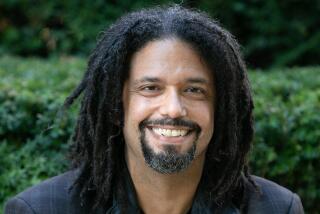History’s arena
- Share via
The story of an Olympic stadium often mirrors the Games themselves, reflecting the political and social history, becoming a window into that era. To see one is to know more -- sometimes much more -- about the place it calls home.
The strong physical image of Beijing’s “Bird’s Nest” National Stadium, of which you will more than likely see plenty when the Summer Games open Friday, seems likely to help strengthen that notion of place. The woven structure, also known as the National Stadium, indeed looks like a giant steel version of a delicate avian den. Between the opening and closing ceremonies in Beijing, Olympic track and field athletes will run, throw and jump for medals, cheered on by as many as 102,000 spectators.
When all is done, will the stadium represent China’s growing global prominence, its troubled record on human rights or something entirely unforeseen?
Here’s a look back at some of the venues and what they tell us about the place and the event:
--
MUNICH, GERMANY
Like China, Germany had a political history to overcome when it hosted the 1972 Olympics in Munich. Adolf Hitler had used the 1936 Berlin Olympics to spew propaganda before his march across Europe and the Holocaust. The ’72 Games were to show the new Germany. The Munich Olympic motto: the “Happy Games.”
The Games went along happily for the first week. The Olympic Stadium -- constructed with an open roof and a peaked transparent awning over the seats designed to look like the Alps -- hosted the opening ceremony, track and field events and soccer games.
Then came the Munich massacre. Palestinian terrorists killed 11 Israeli athletes and coaches. The Games were halted for 34 hours, and 83,000 attended a memorial service in the stadium.
The facility still attracts 5 million guests yearly for athletic and entertainment events. Munich’s “Happy Games” are remembered mostly for the massacre, though they featured spectacular athletic performances by U.S. swimmer Mark Spitz, who won a record seven gold medals, and Soviet gymnast Olga Korbut, who took home three gold medals.
--
MONTREAL
The 1976 Games in Montreal offered a chance to lift the cloud, but they missed the mark. Because of labor strikes and technical flaws, the stadium and its adjoining tower weren’t completed in time for the Games and came to epitomize the many failures of an event in which the host country didn’t win a single gold medal. The stadium still held Olympic events, but with no signature tower or roof, which were finished years later.
The structure clearly was elegant, but the design flaws meant the retractable roof never properly retracted and what was to be the world’s tallest leaning tower (556 feet) was too heavy for its planned concrete base. With subsequent repairs and engineering expenses, the stadium cost more than double its initial estimate and became known as “the Big Owe.” The city spent the next 30 years paying off the Olympic debt.
The stadium wasn’t the only problem. Another Montreal venue’s three-digit scoreboard meant that Romanian gymnast Nadia Comaneci’s perfect “10” showed as 1.00 instead. And the Olympic flame was extinguished by a rainstorm three days into the Games.
--
LOS ANGELES
In 1984, the Los Angeles Memorial Coliseum made history as the only stadium to host the Olympic Games twice. It was not initially built for the Olympics but, rather, as a tribute to World War I veterans.
Los Angeles was the site of the 1932 Olympics, which had no other bidders because of the Depression. These games had the first Olympic village and first victory podium. For the 1984 Games, L.A. again had no Olympic bid competitors, probably because other nations were skittish after seeing Montreal’s huge cost overruns.
--
AMSTERDAM
Amsterdam’s Olympic Stadium, built for the 1928 Summer Games, is memorable as the site of the first modern Olympic flame. It burned in a bowl atop Marathon Tower, connected to the stadium. Just below the bowl, the tower held speakers that broadcast announcements to the 31,600 seats below, another Olympic first.
The stadium, designed by Jan Wils, is thought to be one of the best examples of the Amsterdam School style of architecture. The architect updated the structure in 1937, more than doubling its seating size and adding a bike track. It hosted post-Olympic soccer games and other sporting events.
Amsterdam’s stadium was almost the first Olympic stadium to be demolished. The city decided to convert the land for housing in 1987, but another agency put it on a historical monument list, saving it from destruction. The stadium underwent renovation back to its 1928 size and is still in use today. Visitors can tour the stadium’s catacombs, which are part of the Olympic Experience, an interactive multimedia museum featuring Dutch athletes.
--
--
(BEGIN TEXT OF INFOBOX)
Do you know your Olympic champs?
What year and in what sport did these U.S. Olympic champions first make their mark in the Games? (Answers below.)
1. Bob Beamon
2. Cassius Clay
3. Bruce Jenner
4. Sugar Ray Leonard
5. Greg Louganis
6. Bob Mathias
7. Jesse Owens
8. Wilma Rudolph
9. Don Schollander
10. Jim Thorpe
On travel.latimes.com
For photos of other Olympic stadiums and the building of the “Bird’s Nest,” go to latimes.com/olympicstadiums.
Answers: 1. 1968, long jump 2. 1960, boxing 3. 1976, decathlon 4. 1976, boxing 5. 1984, diving 6. 1948, decathlon 7. 1936, track and field 8. 1960, track and field 9. 1964, swimming 10. 1912, decathlon and pentathlon
More to Read
Go beyond the scoreboard
Get the latest on L.A.'s teams in the daily Sports Report newsletter.
You may occasionally receive promotional content from the Los Angeles Times.







